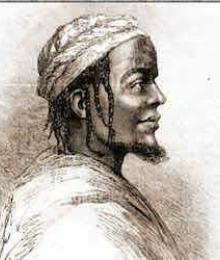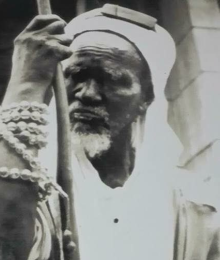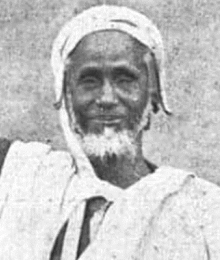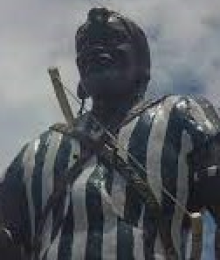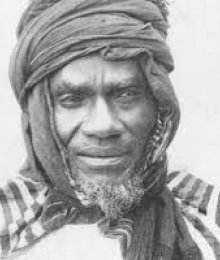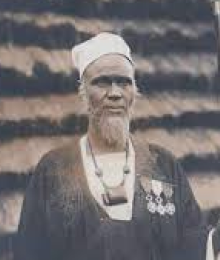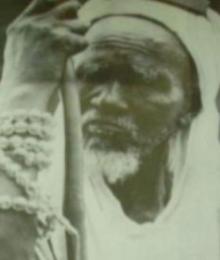
El Hadj Oumar Foutiyou Tall (1794–1864) was a major figure in 19th-century West African history. A Muslim scholar, charismatic ruler, and formidable military leader, he was born in Fouta-Toro (present-day Senegal) and became the leading representative of the Tijaniyya Sufi brotherhood in sub-Saharan Africa after a long pilgrimage to Mecca. Beginning in 1850, he launched a series of conquests in the name of jihad, establishing a vast Toucouleur empire that spanned present-day Senegal, Guinea, Mali, and Mauritania.
Facing resistance from both traditional local powers and French colonial forces, he imposed an Islamic theocratic state governed by Quranic law. His mysterious disappearance in the Bandiagara caves in 1864 further cemented his legend. While his legacy remains complex—hailed as an anti-colonial hero in Senegal yet viewed as an invader in Mali—he remains one of the most influential figures in the spread of Islam in West Africa.
Introduction
El Hadj Oumar Foutiyou Tall, an iconic figure in West African history, was born between 1794 and 1797 in Halwar, Fouta-Toro, in what is now Senegal. He came from a prestigious Fulani family and was the fourth of twelve children of Saidou Tall, a respected notable of the Torodbe lineage, and Sokhna Adama Aïssé Thiam.
From a young age, Oumar displayed a deep interest in Islam. His initial religious education was provided by Abd el-Karim, a Muslim scholar from Fouta-Djalon and a member of the Tijaniyya Sufi order. This encounter marked the beginning of a spiritual journey that would transform not only his life but also the political and religious landscape of West Africa.
Journey and Spiritual Training
In 1827, Oumar Tall embarked on a journey that would last eighteen years and permanently shape his vision of the world and Islam. This spiritual and intellectual odyssey first led him to Hamdallaye on the banks of the Niger River, where he met Cheikhou Amadou, founder of the theocratic Macina Empire. He then spent several months in Sokoto, at the court of Mohammed Bello, before crossing the Fezzan desert to reach Cairo.
The pinnacle of his travels was his arrival in Mecca in 1828, where Muhammad Al Ghâlî conferred upon him the prestigious titles of El Hadj and caliph of the Tijaniyya Sufi order for the Sudan region. In 1833, he officially joined the Tijaniyya through Mohammed el-Ghali Boutaleb, a scholar from Fez whom he met in Mecca.
His period of training continued at Al-Azhar University in Cairo, followed by stays at the courts of various Muslim rulers in Africa. These experiences not only deepened his knowledge of Islam but also allowed him to forge strategic alliances that he would later utilize. During his travels, he contracted several prestigious marriages, including with the daughter of the Sultan of Bornu and with a daughter of Mohammed Bello, further consolidating his ties with the region’s ruling families.
Preacher and Founder
Returning to West Africa in 1845, El Hadj Oumar entered a period of intense preaching that lasted thirteen years. He spread Sunni Islam according to the Ashʿarite doctrine, Maliki jurisprudence, and the Tijaniyya Sufi teachings, first in Fouta-Djalon and then in Dinguiraye (in present-day Guinea) from 1848 onward.
In Dinguiraye, he founded a religious community that quickly became a center of attraction for many followers. His reputation as a saintly man spread across the region, drawing an increasing number of disciples, who would later form the core of his army. It was also during this period that he began preparing for the jihad (holy war) that would disrupt the balance of power in West Africa.
Conqueror and Empire Builder
From 1850 onwards, El Hadj Oumar launched his military campaign against non-Muslim populations in the region. His army, equipped with light European weapons obtained from British traders in Sierra Leone, proved formidable. With the support of the Malinkés and the Moors, he successively conquered the territories of the Serers, Wolofs, Soninkés, Khassonkés, and the Bambouk region in 1853.
In 1854, he attacked the Massassi Bambaras and captured their capital, Nioro. Two years later, he annexed the Bambara kingdom of Kaarta, ruthlessly suppressing uprisings against his authority. To secure his conquests, he built strategic fortifications (tatas), notably in Koniakary, 77 kilometers west of Kayes.
His territorial expansion inevitably brought him into conflict with French colonial forces. In April 1857, he declared war on the Khasso kingdom, a French ally, and besieged the fort of Médine. This siege, which lasted several months, was ultimately lifted on July 18, 1857, by troops led by Governor Louis Faidherbe.
Between 1858 and 1861, El Hadj Oumar focused on the Bambara kingdoms of Kaarta and Ségou. After the decisive Battle of Ngano, he conquered Ségou on March 10, 1861, entrusting its administration to his son Ahmadou a year later.
The final phase of his conquests took him to Hamdallaye, the capital of the Fulani Empire of Macina. This campaign was particularly bloody, causing over 70,000 deaths in three battles. Hamdallaye finally fell on March 16, 1862, marking the territorial peak of the Toucouleur Empire founded by El Hadj Oumar.
The Mysterious End of a Conqueror
The conquest of Macina, however, provoked strong resistance, particularly from Ba Lobbo, a cousin of the deposed ruler. A rebellion erupted in the newly conquered territories, forcing El Hadj Oumar to return to Hamdallaye in the spring of 1863 to suppress the uprising.
Despite his efforts, the situation quickly deteriorated. By June 1863, combined Fulani and Kounta forces besieged his army in Hamdallaye. After months of resistance, the city fell in February 1864. El Hadj Oumar managed to escape and sought refuge in the caves of Deguembéré, near Bandiagara, in the cliffs of Dogon country.
This is where his story ends mysteriously. On February 12, 1864, El Hadj Oumar Tall disappeared under circumstances that remain unclear to this day. This enigmatic end has contributed to his legend and reinforced the mystical aura surrounding his persona.
Organization of the Toucouleur State
The empire founded by El Hadj Oumar Tall spanned present-day Guinea, Senegal, Mauritania, and Mali. It was organized as an Islamic theocracy, where Quranic law formed the foundation of governance.
To administer this vast territory, El Hadj Oumar relied on a council consisting of prominent marabouts, some of his brothers, and pilgrimage companions. Administratively, he drew inspiration from the Egyptian-Turkish model, with power divided between a civil governor (pasha) and a military governor (bey).
Each province had a powerful fortress (tata) commanded by a military leader overseeing a significant garrison. This system helped maintain order in the conquered territories and swiftly suppress any rebellion attempts.
Spiritual and Political Legacy
After El Hadj Oumar’s disappearance, his nephew Tidiani Tall succeeded him and established the Toucouleur Empire's capital in Bandiagara. His son Ahmadou Tall continued to rule over Ségou and Nioro, controlling the Niger from Sansanding to Nyamina, part of the Bambara regions of Beledougou and Bakhounou, as well as Kaarta until the French conquest in 1893.
Another son, Aguibou Tall, became the king of Dinguiraye before being appointed Sultan of Macina by the French in 1892, marking the end of the empire’s independence and its gradual absorption into French West Africa.
Controversial Legacy
The state founded by El Hadj Oumar Tall exhibited contradictory aspects. Driven by the universalist ideology of Islam and a vision of societal reform based on equality, he promoted the liberalism of Sunni Islam through the Tijaniyya brotherhood and sought to impose a "transcendent fraternity" upon the peoples of Western Sudan.
However, like other Islamic states of the time, the Toucouleur Empire thrived in part due to the slave trade, thus perpetuating practices that Islam, in its egalitarian spirit, should have condemned.
El Hadj Oumar Tall remains an ambivalent figure in African history: a religious reformer, a ruthless conqueror, an anti-colonial resistance leader, and a state builder. His legacy continues to inspire many West African Muslims, particularly within the Tijaniyya brotherhood, which regards him as a forerunner of the great Muslim sheikhs of the region, such as Mbaba Diakhou, El Hadj Malick Sy, and Cheikh Ibrahim Niasse.
In November 2019, the French government returned the so-called "Omar Tall sword" to Senegal—though it actually belonged to his son Ahmadou—marking a symbolic step in recognizing his historical significance and in the broader process of restituting African cultural heritage.
Through the centuries, the figure of El Hadj Oumar Foutiyou Tall continues to fascinate historians and novelists, as evidenced by his presence in Maryse Condé’s historical novel Ségou. His epic remains a crucial chapter in the history of 19th-century West Africa, illustrating the complex dynamics between Islam, anti-colonial resistance, and state-building in the region.











